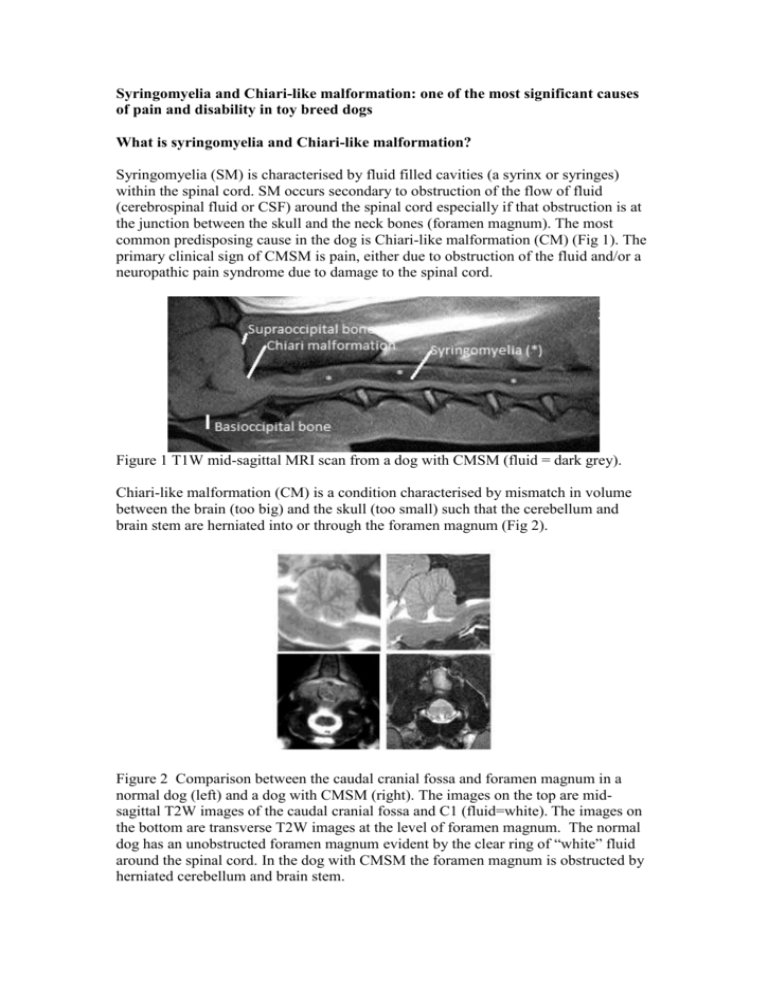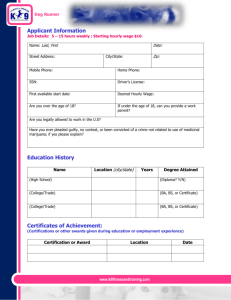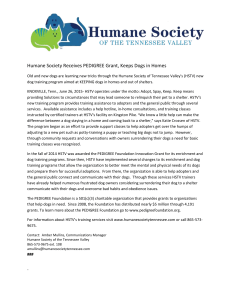Canine Chiari-like Malformation And Syringomyelia
advertisement

Syringomyelia and Chiari-like malformation: one of the most significant causes
of pain and disability in toy breed dogs
What is syringomyelia and Chiari-like malformation?
Syringomyelia (SM) is characterised by fluid filled cavities (a syrinx or syringes)
within the spinal cord. SM occurs secondary to obstruction of the flow of fluid
(cerebrospinal fluid or CSF) around the spinal cord especially if that obstruction is at
the junction between the skull and the neck bones (foramen magnum). The most
common predisposing cause in the dog is Chiari-like malformation (CM) (Fig 1). The
primary clinical sign of CMSM is pain, either due to obstruction of the fluid and/or a
neuropathic pain syndrome due to damage to the spinal cord.
Figure 1 T1W mid-sagittal MRI scan from a dog with CMSM (fluid = dark grey).
Chiari-like malformation (CM) is a condition characterised by mismatch in volume
between the brain (too big) and the skull (too small) such that the cerebellum and
brain stem are herniated into or through the foramen magnum (Fig 2).
Figure 2 Comparison between the caudal cranial fossa and foramen magnum in a
normal dog (left) and a dog with CMSM (right). The images on the top are midsagittal T2W images of the caudal cranial fossa and C1 (fluid=white). The images on
the bottom are transverse T2W images at the level of foramen magnum. The normal
dog has an unobstructed foramen magnum evident by the clear ring of “white” fluid
around the spinal cord. In the dog with CMSM the foramen magnum is obstructed by
herniated cerebellum and brain stem.
How common is syringomyelia and chiari-like malformation?
Brachiocephalicism and miniaturization appear to be risk factors for CM. The
condition is most commonly reported in toy breeds such as the Cavalier King Charles
spaniels, King Charles spaniels, Griffon Bruxellois, Affenpinschers, Yorkshire
terriers, Maltese, Chihuahuas, Pomeranians, and Papillons. Partly because of its
popularity as a pet, the CKCS is overrepresented. Studies into the inheritance of SM
associated with CM in CKCS have shown it to be a complex trait with a moderately
high heritability. It has a varying age of onset – there is 46% prevalence in
asymptomatic breeding CKCS but prevalence increases with age and may be as high
as 70% in dogs over six years of age.
What are the clinical signs of syringomyelia and Chiari malformation?
The most important and consistent clinical sign of CM/SM is pain however this may
be difficult to localise. Owners may describe postural pain; for example pain on
jumping or being picked up. Sleeping with the head in unusual positions may be
reported. Pain is positively correlated with syrinx width and symmetry i.e. dogs with
a wider asymmetrical syrinx are more likely to experience discomfort, and dogs with
a narrow symmetrical syrinx may be asymptomatic. Syrinxes can progressively
expand and a dog which is asymptomatic in early life may eventually become painful.
Dogs with a wide syrinx may also scratch, typically on one side only, while the dog is
walking and often without making skin contact, such behaviour is often referred to as
an “air guitar” or “phantom” scratching. Dogs with a wide syrinx are also more likely
to have curvature of the spine (scoliosis). SM may result in other neurological deficits
such as weakness and poor coordination. Seizures, balance (vestibular) disorders,
facial nerve paralysis (Bell’s palsy) and deafness may also be seen; however, no direct
relationship has been proven and this association may be circumstantial.
CM alone appears to cause significant head and spinal pain in some dogs
How is syringomyelia and Chiari malformation diagnosed?
Magnetic resonance imaging (MRI) is essential for diagnosis and determining the
cause and extent of SM.
How is syringomyelia and Chiari malformation treated?
The main treatment objective is pain relief and dogs may be medically and/or
surgically managed. There is no cure and at best treatment improves signs. The
clinical signs of CMSM are often progressive – a recent study found that
approximately three-quarters of CKCS with CMSM associated neuropathic pain will
deteriorate on conservative treatment only. The most common surgical management is
cranial/cervical decompression (also described as foramen magnum or suboccipital
decompression) in essence creating more space for the brain by removal of bone. Due
to the persistence of SM and/or spinal cord dorsal horn damage it is likely that the
post-operative patient will also require continuing medical management for pain relief
and in some patients medical management alone is chosen because of financial
reasons or owner preference. There are three main drugs used for treatment of
CM/SM: drugs that reduce CSF production e.g. cimetidine or omeprazole or possibly
diuretics such as furosemide; analgesics; and corticosteroids. Simple actions, for
example raising the food bowl and removing neck collars, can also help.
How can syringomyelia and Chiari malformation be prevented
Breeders
It is recommended that breeders of dogs predisposed to CMSM screen their stock.
Current breeding recommendations for CKCS concentrate on removal of dogs with
early onset SM from the breeding pool (for more information see
http://www.veterinary-neurologist.co.uk/sm_screening_breeders.htm). A British
Veterinary Association (BVA) / Kennel Club (KC) CMSM Scheme is due to launch
in early 2012. To participate in the scheme, owners will need to have their dog MRI
scanned in a veterinary practice and many practices offer a reduced cost CMSM MRI
service. The MRI scans will be reviewed by two scrutineers from a BVA-appointed
panel of neurologists and radiologists and graded for severity for both CM and SM.
Results for dogs registered with the Kennel Club will be sent to the club for
publication on its online Health Test Results Finder and to the Animal Health Trust to
be included in Estimated Breeding Value (EBV) calculations for a Mate Select
Computer program. The Kennel Club will begin to publish the results once the first
batch is available. This is expected to be by the end of the first quarter of 2012. In the
meantime, the Health Test Results Finder will indicate that the dog has been screened
and that results are available from the owner.
Estimated Breeding Values (EBVs) have the advantage that they are available for all
registered dogs even if the dog has not been MRI scanned or is below the minimum
age for screening. They also have the potential to eliminate environmental factors
normally associated with a complex trait.
Pet Owners
Owning a dog with CMSM can be distressing and expensive. It is recommended that
pet owner wishing to purchase a breed of dog susceptible to syringomyelia.
Request to view parents and the grandparents CMSM reports or certificates. A
responsible breeder is one that health tests and is proud and eager to show a
puppy buyer their certificates.
Ascertain that the breeder is adhering to the appropriate breed club guidelines
e.g. age at breeding and screening for other inherited diseases.
Veterinary Surgeons
If a dog has a MRI diagnosis of CMSM then the kennel club registration and or
pedigree details should be submitted together with the MRI report to the Animal
Health Trust ('Dr Sarah Blott' (sarah.blott@aht.org.uk) for inclusion in the EBV
database
Future directions
Work to identify the genetic cause of Chiari-like malformation and syringomyelia is
underway with a view to eventually establishing a DNA screening test.
There is concern that in some breeds CM is so common that it may be a fixed genetic
trait. The subsequent development of SM may be dependent on other modifying or
protective genes which influence severity and age of onset. It is possible that
attempting to select for SM free dogs and using an EBV Mate Select Program may
merely select for protective traits, reducing the incidence of clinical and early disease
but without reducing the prevalence of the main gene(s) for SM associated with CM.
In this instance the only way to reduce the incidence of disease would be to introduce
new DNA by outcrossing to a different breed that does not have inherited CM.
Summary
CMSM is an inherited disease which can cause chronic pain and disability and
is prevalent in several toy breed dogs
Even with treatment many dogs with CMSM continue to suffer pain and
distress.
Diagnosis of CMSM is by MRI which is expensive are often requires referral
to specialist facilities.
Treatment for CMSM is often lifelong and the signs of CMSM are progressive
in many dogs.
Advisory Council Recommendations
Breeders of dogs predisposed to CMSM should screen their stock though an
official scheme and base their breeding choices on an EBV system (if
available).
Prospective pet owners should be advised on how to select a puppy with a
lower chance of inherited disease.
Veterinary surgeons should be encouraged to submit pedigree information
about dogs clinically affected with CMSM to a central database.
Research into more effective treatment and prevention of CMSM should be
continued



